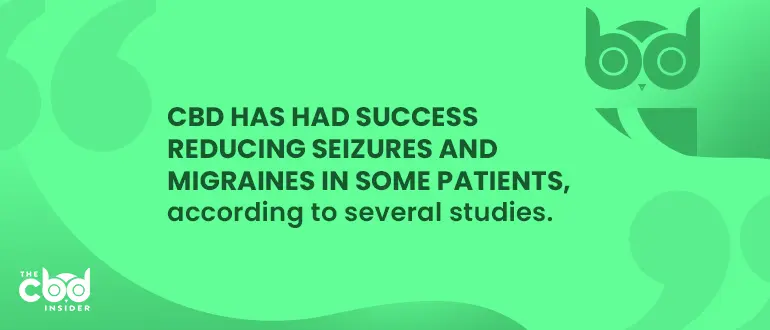-
- Market Research
- |
- CBD Near Me
- |
- Giveaways
- |
- Newsletter
- |
- Contact
- |
- Advertise
- |

Table of Contents
- A Brief History of the Endocannabinoid System
- What Is the Purpose of the Endocannabinoid System?
- What Does the Endocannabinoid System Consist Of?
- Cannabinoid Receptors
- Endocannabinoids
- Enzymes
- How Does CBD Interact With the Endocannabinoid System?
- CBD and Cannabinoid Receptors
- CBD and Non-Cannabinoid Receptors
- CBD’s Interaction With Endocannabinoids and Enzymes
- The Endocannabinoid System in Action (And How CBD Can Help)
- The Endocannabinoid System in the Brain
- The Endocannabinoid System in the Immune System
- The Future of the Endocannabinoid System and CBD
The endocannabinoid system (ECS), the system cannabidiol (CBD) and other cannabinoids interact with, is a relatively recent discovery in science (1992), but scientists are quickly realizing the ECS is a vital element for maintaining a healthy body. Essentially, the ECS helps the human body maintain homeostasis, balancing bodily systems to make sure everything is just right. For instance, the ECS helps regulate neuronal activity and prevents inflammation from getting out of hand.
However, like with other bodily systems, the endocannabinoid system may become deficient. Researchers have linked ECS deficiency with many illnesses including Crohn’s disease, epilepsy, and PTSD. Research suggests CBD may help restore balance in the body by improving the function of the ECS, helping with several conditions as a result.
Table of Contents
- A Brief History of the Endocannabinoid System
- What Is the Purpose of the Endocannabinoid System?
- What Does the Endocannabinoid System Consist Of?
- Cannabinoid Receptors
- Endocannabinoids
- Enzymes
- How Does CBD Interact With the Endocannabinoid System?
- CBD and Cannabinoid Receptors
- CBD and Non-Cannabinoid Receptors
- CBD’s Interaction With Endocannabinoids and Enzymes
- The Endocannabinoid System in Action (And How CBD Can Help)
- The Endocannabinoid System in the Brain
- CBD Can Help Neurons by Interacting With the Endocannabinoid System
- The Endocannabinoid System in the Immune System
- CBD Can Suppress Inflammation by Interacting With the Endocannabinoid System
- The Future of the Endocannabinoid System and CBD
A Brief History of the Endocannabinoid System
The foundation for the discovery of the endocannabinoid system began with research on the cannabis plant and the compounds found within it, which are called cannabinoids. The first cannabinoid discovered was cannabinol (CBN) in 1895.
This discovery eventually led to the identification of cannabidiol (CBD) in 1940. In 1964, Israeli Professor Raphael Mechoulam—now one of the world’s leading cannabis researchers—isolated and identified the psychoactive compound of cannabis, tetrahydrocannabinol (THC).
As further research was conducted on these cannabinoids, scientists discovered they possessed therapeutic benefits. However, they did not understand how these effects were produced in people and animals.
In 1988, cannabinoid receptors were discovered in the brains of animals. This discovery helped scientists learn how cannabinoids worked. The presence of cannabinoid receptors meant organisms were naturally built to interact with cannabinoids.
This breakthrough led scientists to theorize that humans and animals produced their own cannabinoids.
In 1992, Lumír Hanuš—a scientist working under Professor Mechoulam—confirmed this hypothesis by discovering and identifying the first endocannabinoid: anandamide. As a result, the endocannabinoid system was officially discovered.
Since the discovery of the endocannabinoid system, scientists have conducted numerous studies to further their understanding. While more studies are needed, scientists believe they know its purpose, its components, and how it may be influenced to potentially treat a host of illnesses.
What Is the Purpose of the Endocannabinoid System?
The endocannabinoid system is responsible for balance in the body, which is known as homeostasis.
Homeostasis is the body’s tendency to reach equilibrium, such as body temperature, blood sugar levels, and much more.
These bodily processes require a delicate balance, and the ECS helps many of them remain stable.
What Does the Endocannabinoid System Consist Of?
Three major elements make up the endocannabinoid system: cannabinoid receptors, endocannabinoids, and the enzymes which regulate endocannabinoids.
Cannabinoid Receptors
Cannabinoid receptors reside on the surface of cells, allowing endocannabinoids to produce their effects directly to the cell.
There are two main cannabinoid receptors: CB1 and CB2.
CB1 receptors are most abundant in the brain, residing primarily on nerve cells. Thus, they modulate memory, pain, motor control, and several other aspects of mental health.
CB2 receptors are most abundant on immune cells and primarily modulate inflammatory responses.
Endocannabinoids
When a bodily process becomes imbalanced, the endocannabinoid system releases the appropriate endocannabinoids to stabilize the process and return the body to homeostasis.
The two major endocannabinoids are anandamide and 2-AG.
Anandamide is a neurotransmitter, but it works in reverse of other neurotransmitters. Instead of sending signals, it ensures neurons are not overloaded with signals. This is called retrograde neurotransmission.
Research has also shown anandamide possesses therapeutic benefits including pain relief and improving mood. It has also been known to reduce anxiety and depression and may be one of the contributing factors to runner’s high.
2-AG, which is shorthand for 2-Arachidonoylglycerol, is the other main endocannabinoid compound and is more abundant than anandamide. Like anandamide, 2-AG is also in the brain, but it binds better with the CB2 receptor.
As a result, 2-AG is known to have a role in immune system function, specifically inflammation.
Enzymes
The primary goal of enzymes is to break down endocannabinoids when they have finished their jobs.
Two main enzymes make up this third section of the endocannabinoid system: fatty acid amide hydrolase (FAAH) and monoacylglycerol lipase (MAGL).
FAAH predominantly breaks down anandamide while MAGL mostly breaks down 2-AG, yet either enzyme can break down the other endocannabinoid.
How Does CBD Interact With the Endocannabinoid System?
Phytocannabinoids (cannabinoids from plants, as opposed to from the body), like CBD, also interact with the endocannabinoid system.
CBD and Cannabinoid Receptors
CBD does not directly bind with the CB1 or CB2 receptors. Instead, CBD interacts with these receptors allosterically (i.e., indirectly), influencing how the receptor interacts with endocannabinoids or other phytocannabinoids.
For example, CBD can prevent THC from activating the CB1 receptor by allosterically modulating CB1. This effect by CBD inhibits the psychoactive effects of THC.
CBD works similarly with the CB2 receptors, as CBD peripherally activates CB2 to produce anti-inflammatory benefits.
CBD and Non-Cannabinoid Receptors
Interestingly, CBD does not directly bind with cannabinoid receptors, but it will with receptors separate from the endocannabinoid system.
One such set of receptors CBD interacts directly with is the TRPV1, or vanilloid, receptors. These receptors are responsible for pain perception. When CBD binds with them, they produce analgesic effects.
CBD also interacts with serotonin receptors. When activated, the receptors help reduce stress and anxiety levels, making CBD potentially helpful for people who struggle with anxiety and depression.
CBD’s Interaction With Endocannabinoids and Enzymes
In addition to interacting with receptors, CBD affects endocannabinoids and their enzymes.
CBD allows endocannabinoids to last longer in the body by inhibiting their enzymes from breaking down endocannabinoids as quickly as they otherwise would. This is helpful when treating illnesses that benefit from an increase in endocannabinoids.
The Endocannabinoid System in Action (And How CBD Can Help)
The following examples illustrate how all three components of the endocannabinoid system work to regulate the proper functioning of the brain and immune system, as well as how CBD can supplement the ECS when disease strikes.
The Endocannabinoid System in the Brain
Neurons send signals in the brain that have instructions for the rest of the body. Sometimes, neurons can become hyperactive.
When this happens, the ECS kicks in by sending endocannabinoids — such as anandamide — to slow down these neurons. Once anandamide and other endocannabinoids have finished their job, enzymes break them down and everything returns to homeostasis.
However, chronic neurological diseases that create hyperactive neurons such as epilepsy and migraine can occur, and the ECS may be unable to restore balance.
CBD Can Help Neurons by Interacting With the Endocannabinoid System
Since CBD inhibits endocannabinoid enzymes, anandamide can last longer and attempt to bring neurons back to homeostasis. CBD has had success reducing seizures and migraines in some patients, according to several studies.
The Endocannabinoid System in the Immune System
The immune system has many responsibilities. One of those is to attack foreign invaders like viruses. When this occurs, a typical immune response is inflammation.
Inflammation is the immune system’s way of removing the virus from the body by releasing proinflammatory proteins called cytokines. During the inflammatory response, the body releases endocannabinoids to regulate the inflammation and eliminate the remaining cytokines once the virus has been removed.
Once the inflammation subsides, enzymes break down the endocannabinoids.
However, in a patient with an autoimmune disease such as Crohn’s disease or multiple sclerosis, the immune system can perceive natural or harmless substances as “foreign” and attack them. This faulty response produces chronic inflammation and pain follows.
CBD Can Suppress Inflammation by Interacting With the Endocannabinoid System
Supplementing the endocannabinoid system with CBD may help suppress inflammation.
CBD can inhibit cytokines by activating specific cannabinoid receptors such as CB2, speeding up the natural death of cytokines and reducing inflammation. Additionally, this can relieve pain caused by inflammation.
The Future of the Endocannabinoid System and CBD
As our understanding of the endocannabinoid system grows, so does our ability to manipulate it for therapeutic benefits.
CBD is quickly gaining scientific support as one such way to safely and effectively influence the ECS for the treatment of illnesses.
CBD has promising research behind it as a treatment for many conditions including epilepsy, migraine, Crohn’s disease, multiple sclerosis, asthma, neurodegenerative diseases like Alzheimer’s, and more that are currently unknown.
We need to conduct more clinical research to confirm its benefits.
Research on CBD is especially crucial for these illnesses since some people cannot find relief with currently available treatments. Supporting new research could help make CBD more readily available as a therapy for those who may need it.
Thankfully, the number of high-quality studies are proliferating as public opinion continues to support CBD. Not only will this research further develop our understanding of CBD as a therapy, but it will also increase knowledge of how the ECS works, providing hope that more conditions may be treated safely and more effectively.
Have you used CBD to help restore your body’s balance? If so, let us know in the comments about your experience with CBD!
Disclaimer: The content on this site is for informational purposes only. We are not medical experts and nothing should be construed as medical advice. Be sure to speak with your physician before taking CBD or any other treatment.











